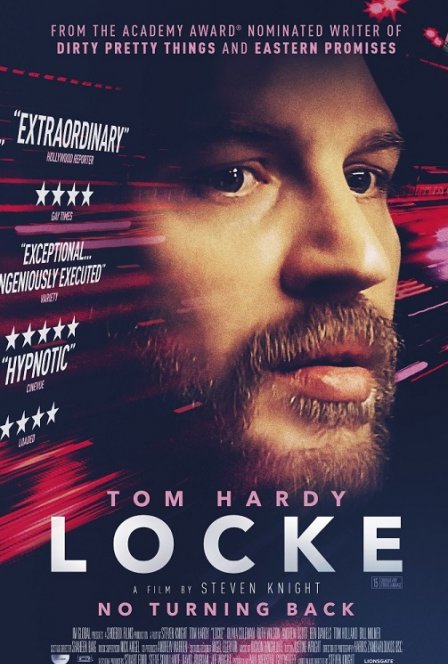Locke shouldn’t work. Not as a movie, at least. When you rattle them off aloud or in print, the core elements of Steven Knight’s screenplay seem more suited to a short story format than to a visual medium. A man, alone in the BMW that serves as the sole setting for the story, drives furiously through the night while conducting a near-constant stream of conversations with fewer than a dozen other characters, none of whom is ever seen and barely half of whom are significant. One of Ivan Locke’s (Tom Hardy) interlocutors never speaks at all. The dialogue concerns nuances of concrete pouring, filial piety, fidelity, rectitude. The camera occasionally quits the cabin of Locke’s sedan for a moment to show his progress up the highways to London, but in narrative terms the story never offers any perspective but his. There’s no scenery for Hardy to chew, just a steering wheel and a rear view mirror and a hands-free speakerphone. For all Locke’s forward travel, the audience never gets to go anywhere. These are dynamics typically confined to the page, plastered here across 85 minutes of screentime.
So why does it work? Because, holy shit, does it ever work! Whatever feelings the titular character provokes in you, it’s hard to imagine a neutral reaction to Locke. He’s unlovable, admirable, hopeless, infuriating, rigorously principled, lost in a moralistic maze of his own devising — anything but boring. On paper, watching a man drive and lecture and cajole for an hour and a half should be boring, but Locke never is.
Hardy will probably get most of the credit for that unlikely feat. His captivating performance flicks between an icy, forced calm and the tautness and potential havoc of a steel construction cable. Writer/director Knight (Dirty Pretty Things, Eastern Promises) deserves some praise for midwifing Hardy’s performance and for the film’s lacerating conversations. But really, the lion’s share of the accolades for Locke belong to editor Justine Wright (The Last King Of Scotland, The Iron Lady) and cinematographer Haris Zambarloukos (Camera Obscura, Sleuth).
Zambarloukos turns the familiar visuals of the highway at night into a woozy light show, mixing the regularity and patterns of street lamps with more dizzying fare like traffic and sirens, keeping all of it fuzzy and distant. Hardy is mostly shot from just outside the windows of his car, and the camera jitters along with the road surface in ways that render the driving man’s face blurry and ethereal. Locke is certain of his choices, firm and unrelenting, but Locke is visually unsure quite what to think of him. In Wright’s hands, the subtleties of Zambarloukos’s visual style become a hypnotic tapestry. One abstract shot capturing both Hardy and reflected lights on his windshield is layered over another in which lights are moving perhaps not in the same direction as the first. And then that conflicted veil slides down over a practical interior shot to show who is calling Locke now, or being called. Dickon Hinchliffe’s anxious score helps hold the tapestry together, binding the spell. The film’s audio-visual style insists on ambiguity in a story and character that Knight seems eager to portray as more virtuous than monstrous.
Knight’s words give Locke a starry-eyed grandeur about the building trade. “My building will alter water tables and squeeze granite,” he tells construction colleague Donal, exhorting him to help Locke complete the job he’s just quit not to please the bosses but “for the piece of sky we’re going to steal!” He speaks of softer things like family and love in similarly absolute terms, imagining them somehow less delicate than a concrete foundation. He is utterly alone and reaching out to three different sets of people for a salvation that is far from assured.
The central question hovering behind Locke’s bouncing, glowing cinematic eye is one of debt: what do men owe, and to whom, and in what amounts? What does Ivan owe his wife of 15 years and their children? What does he owe to the construction project he is walking away from on the crucial eve of the largest concrete pour in the history of European building? To the living person he is driving towards and the dead one he is fleeing?
These might not be questions that interest you. They are not necessarily ones that require a 40 foot screen (though the dark anonymity and relative sensory immersion of the theater serve to deepen Locke’s spell). But they get a good workout here thanks to Hardy’s masterful performance, Zambarloukos’s light-touch visual stylistics, and Wright’s sharp stitching. None of them gets answered, of course. It should be enough to be shown Ivan’s answers to them — Knight’s answers, too, it seems — and then interrogate them on your own long ride home.

